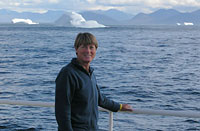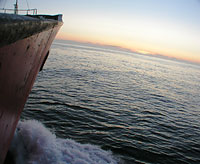

 | |||||||||||||
|
|
Journals 2006/2007Miriam Sutton
September 1, 2006 Final Location: Halifax, Nova Scotia (44° 40' 06.02 N, 63° 36' 20.41" W) Our arrival in Halifax, Nova Scotia this morning ends our one-month scientific voyage in the Labrador Sea. Oh, what an experience I have had. There is so much to reflect on over the past 4 weeks: the people, the research, the scenery, and life at sea. I barely know where to begin. The Canadians welcomed me with open arms from the first day I stepped aboard the CCGS Hudson. The scientists and crew accepted my curiosity and questions with enthusiasm and assisted me in learning about their research, their work, and their research/Search and Rescue (SAR) vessel. I took so many photos during the cruise that a few of them dubbed me the paparazzi but they always smiled when I reminded them that it was "all for the children" back in my classroom. Their willingness to participate in my educational endeavor was most appreciated and I am ever thankful to Paul Fraser for his comments and editing skills in my journal entries. (See CCGS Hudson and GSC photo below.)
The Labrador scenery was amazing: sunsets lasting for hours, northern lights dancing across the sky, icebergs glistening in the sun, and glacial-blue waters cascading off the ship's bow. My most vivid memory of the scenery would never have materialized if not for the unfortunate breakdown of a fishing vessel during our departure from Nain. The CCGS Hudson's SAR call provided an impromptu scenic voyage into the fjords of Saglek Bay and the accompanying vistas were awe inspiring. The Tourngat Mountains flanked by icebergs that followed the Labrador current through Iceberg Alley revealed nature's artistic talent for glaciations. Icebergs as large as the buildings were dwarfed by the magnificent peaks towering shoreward. (See Iceberg and Mountain photo below.)
The circumstances which preceded my Teacher-at-Sea experience required an understanding of perseverance on a whole new level. Although I am hesitant to mention it, the travel quandary I endured prior to boarding the CCGS Hudson became an underlying element throughout my voyage. My luggage was misplaced during my airline travel and did not arrive with me in Canada before the ship's departure from Newfoundland on the 5th of August. One of the scientists drove me to a store in St. John's where I purchased a few clothing and personal items to get me through until the airlines could arrange for my luggage to be transferred to Nain, Labrador during the ship's port call on August 15th. Once on board, the ship's Logistics Officer showed me the ship's laundry facilities and outfitted me in a pair of coveralls and a couple of pair of socks to supplement the pair of jeans, tee shirt, sweatshirt, and other necessities I purchased. I survived quite well on this limited amount of apparel throughout my one-month adventure at sea, as my luggage never made the transfer to Nain. Sometimes, when the world tosses you lemons you just have to learn to make lemonade. I will carry endearing memories of my research voyage aboard the Canadian Coast Guard Ship Hudson and will be forever grateful to the crew and the Geologic Survey of Canada scientists for their compassion and sense of humor. It is difficult to believe that the month is actually over. To the friends I leave behind... May your thoughts be cast upon the Labrador Current,
The Final Activity: Record today's Sea Surface Temperature (SST) and the Air Temperature on the data table you created from the August 05 journal entry. What changes did you observe in your data? How does your data correlate with Ms. Sutton's changes in latitude over the one month research cruise? How did your results compare with the prediction you made on August 5th? The Final Word of the Day: Perseverance |
||||||||||||


